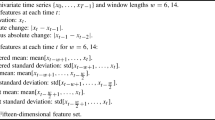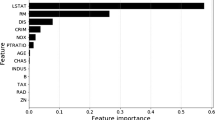Abstract
In this paper, a large set of macroeconomic and financial predictors is used to forecast U.S. recession periods. We propose a sparse Bayesian variable selection in probit model for predicting U.S. recessions. The correlation prior is assigned for the binary vector to distinguish models with the same size, and the sparse prior is specified for the coefficient parameters for the purpose of predicting accurately using fewer parameters. In terms of the quadratic probability score and the log probability score, we demonstrate that the proposed method performs better than other three methods.
Similar content being viewed by others
Notes
The NBER defines a recession as a significant decline in economic activity spread across the economy, lasting more than a few months, normally visible in production, employment, real income, and other indicators.
References
Albert, J. H., & Chib, S. (1993). Bayesian analysis of binary and polychotomous response data. Journal of the American Statistical Association, 88(422), 669–679.
Armagan, A., Dunson, D. B., & Lee, J. (2013). Generalized double Pareto shrinkage. Statistica Sinica, 3(1), 119–143.
Belmonte, M. A. G., Koop, G., & Korobilis, D. (2014). Hierarchical shrinkage in time-varying parameter models. Journal of Forecasting, 33(1), 80–94.
Chen, Z., Iqbal, A., & Lai, H. (2011). Forecasting the probability of recessions: A probit and dynamic factor modelling approach. Canadian Journal of Economics, 44(2), 651–672.
Chhikara, R., & Folks, L. (1989). The inverse gaussian distribution: Theory, methodology, and applications. New York: Marcel Dekker.
Christiansen, C., Eriksen, J. N., & Moller, S. T. (2014). Forecasting US recessions: The role of sentiment. Journal of Banking and Finance, 49, 459–468.
De Mol, C., Giannone, D., & Reichlin, L. (2008). Forecasting using a large number of predictors: Is bayesian shrinkage a valid alternative to principal components? Journal of Econometrics, 146, 318–328.
Devroye, L. (1986). Non-uniform random variate generation. New York: Springer-Verlag.
Estrella, A., & Mishkin, F. S. (1998). Predicting U.S. recessions: Financial variables as leading indicators. Review of Economics and Statistics, 80(1), 45–61.
Fernandez, C., Ley, E., & Steel, M. F. J. (2001). Benchmark priors for Bayesian model averaging. Journal of Econometrics, 100, 381–427.
Fornaro P (2016) Forecasting U.S. recessions with a large set of predictors. Journal of Forecasting. doi:10.1002/for.2388.
Fossati, S. (2012). Dating U.S. business cycles with macro factors. Manuscript, University of Alberta.
Gefang, D. (2014). Bayesian doubly adaptive elastic-net Lasso for VAR shrinkage. International Journal of Forecasting, 30(1), 1–11.
Geman, S., & Geman, D. (1984). Stochastic relaxation, Gibbls distribution, and the Bayesian restoration of images. IEEE Transaction on Pattern Analysis and Machine Intelligence, 6, 721–741.
George, E. I., & McCulloch, R. E. (1993). Variable Selection via Gibbs Sampling. Journal of the American Statistical Association, 88, 881–889.
George, E. I., Sun, D., & Ni, S. (2008). Bayesian stochastic search for VAR model restrictions. Journal of Econometrics, 142, 553–580.
Gilks, W., Richardson, S., & Spiegelhalter, D. (1996). Markov chain Monte Carlo in practise. London: Chapman and Hall.
Katayama, M. (2010). Improving recession probability forecasts in the U.S. economy. Manuscript, Louisiana State University.
Koop, G., & Korobilis, D. (2012). Forecasting inflation using dynamic model averaging. International Economic Review, 53, 867–886.
Korobilis, D. (2013a). Bayesian forecasting with highly correlated predictors. Economics Letters, 18(1), 148–150.
Korobilis, D. (2013b). Hierarchical shrinkage priors for dynamic regressions with many predictors. International Journal of Forecasting, 29(1), 43–59.
Korobilis, D. (2012). VAR forecasting using Bayesian variable selection. Journal of Applied Econometrics, 28(2), 204–230.
Korobilis, D. (2016). Prior selection for panel vector autoregressions. Computational Statistics and Data Analysis, 101, 110–120.
Lamnisos, D., Grin, J. E., & Steel, F. J. Mark. (2009). Transdimensional sampling algorithms for Bayesian variable selection in classification problems with many more variables than observations. Journal of Computational and Graphical Statistics, 18, 592–612.
Li, Q., & Lin, N. (2010). The Bayesian Elastic Net. Bayesian Analysis, 5, 151–170.
Mitchell, T. J., & Beauchamp, J. J. (1988). Bayesian variable selection in linear regression. Journal of the American Statistical Association, 83, 1023–1036.
Panagiotelisa, A., & Smith, M. (2008). Bayesian identification, selection and estimation of semiparametric functions in high dimensional additive models. Journal of Econometrics, 143, 291–316.
Park, K., & Casella, G. (2008). The Bayesian Lasso. Journal of the American Statistical Association, 103, 681–686.
Stankiewicz, S. (2015). Forecasting Euro area macroeconomic variables with Bayesian adaptive elastic net. Manuscript, University of Konstanz.
Stock, J. H., & Watson, M. W. (2002). Forecasting using principal components from a large number of predictors. Journal of the American Statistical Association, 97, 1167–1179.
Stock, J. H., & Watson, M. W. (2012). Generalized shrinkage methods for forecasting using many predictors. Journal of Business and Economic Statistics, 30(4), 481–493.
Wright, J. H. (2006). The yield curve and predicting recessions. Finance and Economics Discussion Series, Federal Reserve Board.
Wright, J. H. (2008). Bayesian model averaging and exchange rate forecasts. Journal of Econometrics, 146, 329–341.
Yuan, M., & Lin, Y. (2005). Efficient empirical Bayes variable selection and estimation in linear models. Journal of the American Statistical Association, 472, 1215–1225.
Acknowledgements
The authors gratefully acknowledge the financial support of the Natural Science Foundation of China (11501294, 11571073), the China Postdoctoral Science Foundation (2015M580374, 2016T90398), the Natural Science Foundation of Jiangsu (BK20141326) and the Research Fund for the Doctoral Program of Higher Education of China (20120092110021).
Author information
Authors and Affiliations
Corresponding author
Appendix: Data description
Appendix: Data description
The data used in Sect. 3 are presented here. The format is as follows: name, transformation code, and brief series description. The transformation codes are \(1=\mathrm{no transformation}\), \(2=\mathrm{first difference}\), \(4=\mathrm{logarithm}\), \(5=\mathrm{first difference of logarithms}\), \(6=\mathrm{second difference of logarithms}\) (Table 4).
Rights and permissions
About this article
Cite this article
Aijun, Y., Ju, X., Hongqiang, Y. et al. Sparse Bayesian Variable Selection in Probit Model for Forecasting U.S. Recessions Using a Large Set of Predictors. Comput Econ 51, 1123–1138 (2018). https://doi.org/10.1007/s10614-017-9660-1
Accepted:
Published:
Issue Date:
DOI: https://doi.org/10.1007/s10614-017-9660-1




